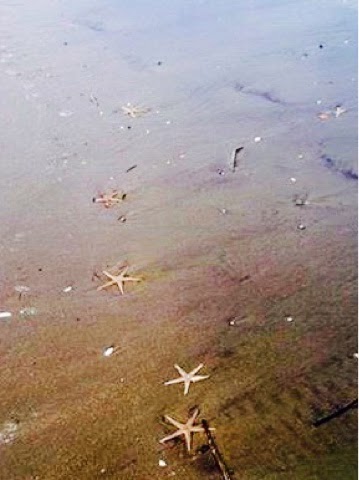Translate
Wednesday, May 27, 2015
Fall clean up
Monday, May 25, 2015
Twinkle twinkle, little starfish Part 2
Today we are going to learn about starfish, with comments from my previous post it has come to my attention that people know very little about starfish, and so I'm sharing what research I have found. Wikipedia says, Starfish or sea stars are star-shaped echinoderms belonging to the Asteroidea class. About 1,500 species of starfish occur on the seabed in all the world's oceans, from the tropics to frigid polar waters.
Starfish are marine invertebrates. They typically have a central disc and five arms, though some species have a larger number of arms. The aboral or upper surface may be smooth, granular or spiny, and is covered with overlapping plates. Many species are brightly coloured in various shades of red or orange, while others are blue, grey or brown. Starfish have tube feet operated by a hydraulic system and a mouth at the centre of the oral or lower surface. They are opportunistic feeders and are mostly predators on benthic invertebrates. Several species have specialized feeding behaviours including eversion of their stomachs and suspension feeding. They have complex life cycles and can reproduce both sexually and asexually. Most can regenerate damaged parts or lost arms and they can shed arms as a means of defense. A few can regrow a complete new disc from a single arm, while others need at least part of the central disc to be attached to the detached part. Regrowth can take several months or years, and starfish are vulnerable to infections during this time.
The scientific name Asteroidea was given to starfish by the French zoologist de Blainvillein 1830. It is derived from the Greek aster, ἀστήρ (a star) and the Greek eidos, εἶδος (form, likeness, appearance). The class Asteroidea belongs to the phylum Echinodermata. As well as the starfish, the echinoderms include sea urchins, sand dollars, brittle and basket stars, sea cucumbers and crinoids. Echinoderms, including starfish, maintain a delicate internal electrolyte balance that is in equilibrium with sea water. This means that it is only possible for them to live in a marine environment and they are not found in any freshwater habitats. Starfish species inhabit all of the world's oceans. Habitats range from tropical coral reefs, rocky shores, tidal pools, mud, and sand to kelp forests, seagrass meadows and the deep-sea floor down to at least 6,000 m (20,000 ft). The greatest diversity of species occurs in coastal areas.
Starfish in Folk lore; An aboriginal Australian fable retold by the Welsh school headmaster William Jenkyn Thomas (1870–1959) tells how some animals needed a canoe to cross the ocean. Whale had one but refused to lend it, so Starfish kept him busy, telling him stories and grooming him to remove parasites, while the others stole the canoe. When Whale realized the trick he beat Starfish ragged, which is how Starfish still is today.
A traditional tale relates how a man walking along a beach saw a boy throwing stranded starfish into the waves. When asked why he was doing this, the boy replied that with the ebbing tide, the starfish would die from exposure. The man pointed out that there were miles and miles of beach and thousands of stranded starfish. What difference could the boy make? The boy bent down and returned another starfish to the ocean. The boy replied: "It makes a difference to this one."
Starfish as food; Starfish are widespread in the oceans, but are only occasionally used as food. There may be good reason for this: the bodies of numerous species are dominated by bony ossicles, and the body wall of many species contains saponins, which have an unpleasant taste, and others contain tetrodotoxins which are poisonous. Some species that prey on bivalve molluscs can transmit paralytic shellfish poisoning.
Some spectacular photos of different kinds...
And the last picture is the one we find regularly. They are very bright orange when we find them alive or freshly dead. They lose their color the longer they've been dead, which is why the ones we showed last post were brown. They are so pretty when they are orange and alive, so we dry them and paint them back to their original color. Hope you enjoyed this lesson on starfish, I'm sure you'll see many more showing up in our art projects, so...stay tuned, the adventure continues!

























































